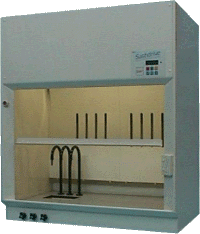Sashdrive Energy Efficient Fume Cupboards
 An elite fume cupboard design in which the sash position is measured and used to regulate the exhaust fan speed.
An elite fume cupboard design in which the sash position is measured and used to regulate the exhaust fan speed.This creates State of Art Airflow in the work space because there is no bypass (secondary air inlet) above the sash, and therefore no internal vortex when two airstreams join together. A vortex is really contaminated air re-circulating inside the fume chamber, and it can be displaced back into the laboratory by room turbulence.
In SashDrive fume cupboards the monolithic air flow inside the fume chamber approaches ideal laminar conditions. Fumes are conveyed along the most direct path to the exhaust duct. Fume containment is enhanced.
It is safe and desirable to work with the sash lowered. Under these conditions, SashDrive fume cupboards exhaust less air volume from the laboratory. The laboratory air contains energy for heating or cooling. At reduced volume flow, energy losses are reduced.
Sashdrive fume cupboards can pay for themselves by saving up to 80% of lost heating energy.
 Click here for pdf installation instructions
Click here for pdf installation instructions
 Click here for pdf typical installation drawing
Click here for pdf typical installation drawing
 Click here for pdf user handbook
Click here for pdf user handbook

